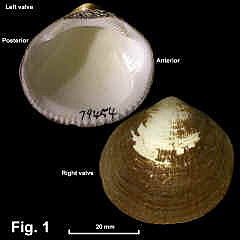|
|
GLYCYMERIDIDAE |
|
|
|
Glycymeris holoserica (Reeve, 1843) Description: Shell solid, heavy, equivalve, nearly equilateral. Shape almost circular. Anterior and posterior ends broadly rounded. Umbones low, almost centrally placed. Hinge line curved, 8-12 teeth each side, area between smooth or with up to 9 weak teeth. Ligament in a wide, triangular pit above hinge. Interior white, sometimes irregularly splashed with brown; muscle scars well defined with a ridge from inner edge of scars towards umbones; margin strongly denticulate. Exterior with fine, widely-spaced radial riblets and dense, weak concentric riblets of about 6 times the density. Periostracum velvety, covering most of the surface in living specimens. Shell colour white underneath periostracum. Size: Up to 44 mm in length. Distribution: Townsville, Qld, southwards to Eden, NSW. Habitat: Most specimens seen are from beach wash-up, either as empty shells or as live specimens washed ashore after storms. Subtidal specimens are from 33 and 37 m. Comparison: The three shallow water species of Glycymeris are distinct in sculpture and colour: G. striatularis Primary sculpture of broad flat ribs, secondary sculpture of fine radials over the whole surface. Colour concentric brown bands. G. holoserica Fine radial and concentric sculpture, periostracum covers most of the shell. G. grayana Relatively large size, smooth shell, periostracum only on ventral margin. Synonymy: Pectunculus hedleyi E. Lamy, 1912 is a synonym (NEW SYNONYM). Iredale (1939) said “… it has more tendency to becoming oblique than [G. holoserica]” and “the umbones were marked with a few yellow dashes”. Inspection of the species in the Australian Museum collection shows the tendency to become oblique to be no more than in G. holoserica. The yellow dashes on the umbones are not apparent. Fig.1: Twofold Bay, NSW (C.79454)
|
|
